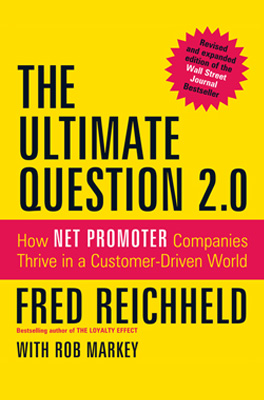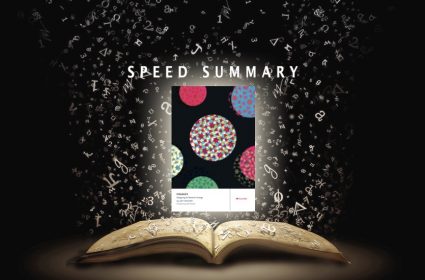The Ultimate Question 2.0: How Net Promoter Companies Thrive in a Customer-Driven World

 The Ultimate Question 2.0: How Net Promoter Companies Thrive in a Customer-Driven World
The Ultimate Question 2.0: How Net Promoter Companies Thrive in a Customer-Driven World- Author: Fred Reichheld and Rob Markey
- Publisher: Harvard
- Publication: 2011
How do brands grow? Whilst there are many paths to growth, none are as sustainable as consistently delighting brand users and reaping the rewards of enhanced loyalty and advocacy. This book shows how to use the Golden Rule – treating others as you’d want to be treated – to do this and thrive in a customer-driven world through profitable customer relationships. The true path to brand growth is through sustainable ‘good profits’ derived from consistently delivering a brand experience worthy of loyalty.
Introduction: From Score to System
You may have heard of The Net Promoter System – it’s a management approach to brand building through ‘good profits’ – ethical profits from enriching lives instead of ‘bad profits’ that exploit brand users. It’s about building relationships worthy of loyalty by treating people so well they become loyal promoters of your brand. It’s about, in the words of Zappos’ Tony Hsieh, consistently WOWing people so they come back for more and tell others. Put simply, it’s about brand enthusiasts talking.
For marketing managers, the Net Promoter System is also a leadership tool for making happiness your business model, and joining a quiet revolution for building a legacy built on ‘good profits’. As an open-source adaptable and flexible system for generating good profits, many companies have adapted the NPS to their own needs and with their own labels (fast-food chain Chick-Fil-A calls it the Raving Fan Index), but successful implementations all share three key elements;
- Systematically categorising brand users into promoters and detractors to produce a net score that monitors the quality of brand relationships, and communicating this throughout the organisation
- Creating ‘closed-loop’ learning and improvement processes to increase promoters and reduce detractors at an operational level. If your NPS score drops, investigate the source of bad business – and put it right
- Treating the creation of more promoters and fewer detractors as mission critical at board level. Developing relationships worth of loyalty is either a strategic priority or it isn’t. If it isn’t NPS is not for you.
Part 1: The Fundamentals of the Net Promoter System
Chapter 1: Bad Profits, Good Profits and the Ultimate Question Customer-centricity is the path to growth because it drives brand loyalty, helping make a company mission-driven as well as profit-driven. Companies know, believe in and can recite the catechism of customer-centricity: “Why do we want brand loyal? Because brand loyalty means people come back more often, buy additional products and services, refer their friends, provide valuable feedback, cost less to serve and are less price sensitive”. Bain & Co found that the Loyalty Effect could boost 25-100% profit boost by increasing retention rates by 5%. As a proxy for whether brand users believe you are worthy of their loyalty, NPS score monitoring can help drive growth via loyalty. For example, market leaders such as Apple, Amazon and Costco create high NPS scores around 80, whilst average firms have a NPS score of 10-20%. Overall, NPS leaders in the US (companies with the highest NPS scores in their category) grow at over twice the rate of the category average. And whilst only 9% of US companies surveyed by Bain & Co have registered sustained profitable growth of 5%+ over the last decade, those 9% have an NPS score 2.3 times those of industry averages.
Chapter 2: The Measure of Success A key challenge of building a business around ‘good profits’ – derived from delivering expectation-building experiences worthy of loyalty, is that you need a simple way to measure user happiness – and then link it to performance. It’s got to be simple, practical and actionable. This NPS ‘Ultimate Question’ – propensity to recommend – is useful because it is both intuitive and adds a critical emotional dimension to the monitoring of loyalty. It also takes into account the referral value of customers. It is a good proxy for business made by smiles created. It’s better than measuring behavioural loyalty because behaviour alone (such as retention rates) might hide a trapped ‘smile-free’ relationship; whilst willingness to recommend (advocacy lies at the top of the loyalty ladder) is indicative of emotional loyalty. Asking about willingness to recommend is also an easier question to answer than asking about abstract concepts like loyalty. But it’s not perfect; firms must establish a question that best links to customer loyalty, and can serve as a proxy for whether their business is built on good or bad profits (or losses).
Chapter 3: How NPS Drives Profitable Growth The Net Promoter System is only useful if it drives action – specifically investing in relationships to build loyalty. Every company would want better relationships with their user base if these relationships were free, but high-quality relationships are not free – they require investment, and reducing reliance on bad profits. So a key step in refocusing a business on relationships is to make the business case for doing so; how much is it worth to turn a detractor into a passive or promoter, what would it be worth to raise our relative NPS by 10 points? To make the case for good profits, you need to know the value of loyalty, and that means estimating the lifetime value of your customer segments – promoters, passives and detractors. Promoters are worth more because they have a higher retention rate, are less price sensitive, have a higher annual spend, are more cost efficient (they cost less to serve than complaining detractors) and refer more. But how much more are they worth? To know this, companies need to segment brand users by user type, measure on these dimensions and then compare the outcomes. Bain, for example, found that a promoter has a lifetime value (LTV) worth $9500 more than a detractor to a US bank.
Chapter 4: The Enterprise Story – Measuring What Matters Enterprise Rent-a-Car has grown to become the number 1 rental car agency in the US with a singular focus on using the Golden Rule (treat users as you’d want to be treated) to generate good profits. It attributes much of its success, growing from $2bn in 1994 to $7bn in 2004, to a single question monitoring system to track customer delight (replacing a lengthy an ineffectual satisfaction survey suffering from question creep), that has allowed the company to drive brand loyalty. Through experimentation, identifying and learning from best practice, closed-loop on-the-spot fixes, ranking branches by the quality of experience delivered, and making quality experience a precondition for promotion, Enterprise has reduced neutral and negative experiences from 12% to 5% since 1994, whilst building growth from loyal promoters.
Chapter 5: The Rules of Measurement Driving growth through loyalty requires an agile loyalty monitoring system – NPS score monitoring can help. Experience shows that effective NPS score monitoring follows certain principles: Principle 1: Ask the Ultimate Question and Very Little Else, Principle 2: Choose a scale and stick to it, Principle 3: Avoid Confusion Between Internal Scores (‘Bottom-Up’ or ‘Touchpoint’) and External Scores (Top-Down, Benchmark or ‘Relationship’ Scores), Principle 4: Aim for High Response Rates from the Right Customers, Principle 5: Report and Discuss NPS Data as Frequently as Financial Data, Principle 6: Learn Faster and Improve Accountability with More Granular Data, Principle 7: Audit to Ensure Accuracy and Freedom from Bias, Principle 8: Validate that Scores Link to Behaviours.
Part 2 Getting Results
Chapter 6: Winning Results with NPS The Net Promoter System is about driving change through a strategic prioritisation and operational focus on brand loyalty – creating more promoters and fewer detractors – by applying the Golden Rule (treating people as you’d want to be treated) – throughout the organisation. Based on experience of NPS adopters, there are three keys to NPS success
- Embracing the goal of brand loyalty as a mission-critical priority at CEO and board level, and understanding the economic, inspirational and moral imperative that a focus on driving loyalty offers
- Hardwiring NPS monitoring feedback into key decision processes and integrating it into operational priorities throughout the organisation to create closed-loop learning and improvement. In other words, not treating it as a metric, or parallel program is critical to success
- Adopting NPS as solution for driving long-term consumer-centric cultural change, rather than a short term program or initiative, and realising the change must touch every part of the organisation
Chapter 7: Economics and Inspiration: The Dual Imperatives The Net Promoter System is like an arch built from two pillars – one economic and the other inspirational. Both are needed for success for driving growth through good profit. The economic pillar is about understanding the business case for investing in brand loyalty, and requires calculating the return on investment on creating more promoters and fewer detractors. It requires having the CFO embrace NPS, and understand why investment in loyalty makes good business sense – and why good profits are more valuable than bad profits. The inspirational pillar of NPS is about helping organisations enrich peoples lives by providing a simple decision rule or ‘heuristic’ – the Golden Rule – for taking decisions across the business, as well as a simple feedback solution – the NPS score – for monitoring how they are living up to this mission. By putting the Golden Rule – ‘is this how I’d want to be treated?’ – top of mind of the business, the NPS makes customer-centricity personal, drives loyalty creation, as well as simplifying complex issues whilst making ethical business decisions communicable, measurable, and actionable.
Chapter 8: Close the Loop with Customers Key to success in driving cultural change and customer-centricity through a focus on brand loyalty using the NPS a core part of daily workflow and core decision processes within the company. Most organisations want to become more customer-focused and the Net Promoter System is a simple solution for achieving this cultural change. Not only does the NPS provide a simple decision heuristic – the Golden Rule – that can be used be used to inform decisions across every level of the organisation, the NPS also hardwires the voice of the user into the organisation by providing creating feedback loops at the front line, mid and senior management levels. Closing the loop at the front line involves monitoring customer experience with NPS and then following up with as many detractors as possible, ideally within 24 hours of the experience. Insights and learning from this ongoing exercise are then pooled, and shared with frontline staff and used to inform decisions. Closing the loop for mid-level managers requires using NPS feedback to create products, services and processes designed to attract and retain high value adopters. Closing the loop for senior executives involves setting up a forum for senior teams to talk with users, and setting NPS targets as a strategic object for business units.
Chapter 9: Organise for the Long Journey The payoff of NPS – a consumer-centric organisation generating good profits through a single-minded focus on brand loyalty – can be substantial. But the commitment required is substantial too. Based on the journey of successful NPS companies there are 7 key requisites of success: 1/ Assign the Right Leaders and Position Them for Success. 2/ Pull The Organisation Together 3/ Reorganise Around the Customer 4/ Hire & Fire the Right People 5/ Be Careful About Linking NPS to Compensation 6/ Don’t Skimp on Support from the IT Department 7 / Never Give Up
Chapter 10: The Road Ahead Building a Golden Rule business thriving on ‘good profits’ is a long road with opportunities and challenges. Two key opportunities include using NPS as to monitor employee experience and loyalty, as Apple, Rackspace, JetBlue and Bain, and developing new NPS monitoring tools using social media; Facebook and Zynga have adopted NPS internally, can their platforms be used to monitor NPS? However there are some key challenges too; dealing with legacy systems not built with consumer-centricity and the prioritisation of brand loyalty in mind, overcoming internal and external resistance from those with vested interests, and ensuring score reliability. In dealing with these opportunities and challenges it is important to keep front of mind the purpose of the Net Promoter System – as a solution for creating a customer-centric organisation that prioritises customer loyalty with decisions that enrich lives, rather than diminish them.



